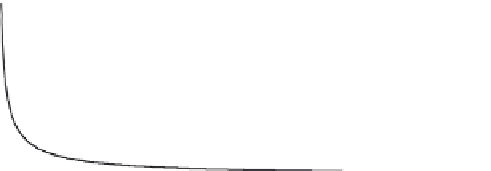Geoscience Reference
In-Depth Information
5
4
f
c +
c
3
2
a
1
b
0
0
1
2
3
4
4
t
+
Fig. 9.14 Scaled vertical infiltration rate into a deep homogeneous soil profile,
f
c
+
=
f
c
/
k
0
as a function of
scaled time
t
+
=
k
0
t
/
A
0
as given by Equation (9.71) (curve a). Also shown are the horizontal
infiltration rate
f
c
+
=
t
−
1
/
2
+
/
2 (curve b), and the time expansion (9.66) as given by (9.67) (curve c);
the dashed line indicates the long-time asymptote
f
c
+
=
1.
Major advantages of (9.68) and (9.69) are that they contain only the two parameters
k
0
and
A
0
and that a number of measurement and simple calculation (see Section 9.2.3)
methods are available for these parameters.
9.3.4
Additional effects
The formulation of potential infiltration, as reviewed here, is for a rather idealized case
of a deep homogeneous soil profile. In field situations there may be such important
complications as the effect of air movement, areal variability and stratification of soil
properties, an impermeable layer at shallow depth, the effect of crusting at the soil
surface, fingering, non-uniform initial water content after redistribution during a period
of drainage and evaporation, and others. Some are briefly touched upon in what follows.
Flow of air
Under certain conditions the movement of air can greatly reduce the movement of infiltrating
water. For example, it is not unusual that, when there is a shallow impermeable layer or a
shallow water table below a relatively flat surface ponded with water, bubbling of air can
be observed; this is evidence of a counterflow of air, which undoubtedly (see Linden and
Dixon, 1975) reduces the water intake rate. Several mathematical formulations have been
developed to describe infiltration as a flow problem of two immiscible fluids. Examples
of these can be found in the studies by McWhorter (1971) and Sonu and Morel-Seytoux
(1976). When the objective is a rigorous physical description of the flow at the Darcy
scale, infiltration should be considered as a two-phase flow phenomenon. However, when
the objective is the derivation of a parametric equation to describe the phenomenon at the
field scale, the one-phase flow assumption, with Richards's equation (8.46), is likely to be



































































































